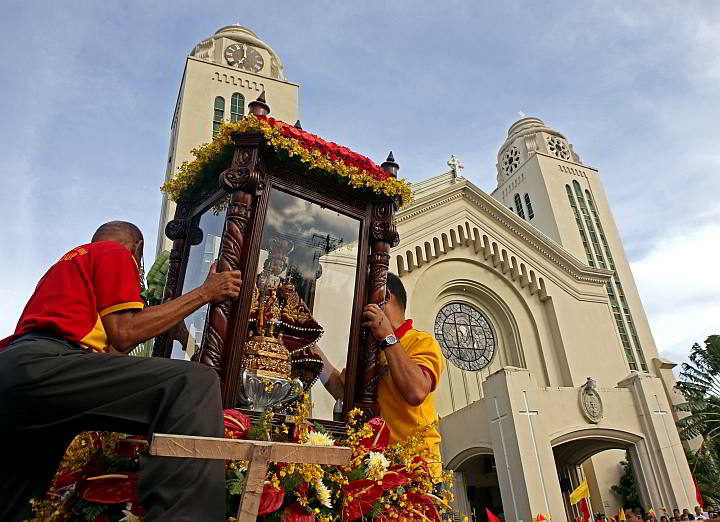How holy icon of Sto. Niño survived WW II hidden in Redemptorist monastery
STO. NIÑO VISITS MAMA

Volunteers carefully unload the glass-encased pilgrim image of the Sto Niño upon arrival at the Redemptorist church after a 6 a.m. motorcade from the basilica. (CDN PHOTO/LITO TECSON)
Kept in a bomb-proof vault, the historic icon of the Sto. Niño de Cebu spent seven months in the safekeeping of Redemptorist priests at the close of World War II.
This little-known page of history was remembered yesterday when hundreds of Catholic faithful followed a 6 a.m. motorcade for the ritual transfer of the icon from the Basilica Minore del Sto. Niño in downtown Cebu city to the all-white Redemptorist church in the uptown area.
Fr. Harold Rentoria, OSA, said bringing the image to the Redemptorist Church, recalls the emergency that arose at the close of 1945. Augustinian caretakers had to find a safe place for the icon be cause the basilica located at Cebu City’s pier area had been heavily bombed.
For Catholics, the symbolism is clear: the child Jesus took shelter in the home of his mother.
The Redemptorists have a special devotion to Mary as Our Lady of Perpetual Help.
Yesterday set the stage for the 450th Kaplag, a week-long celebration of the recovery of the Sto. Niño in the burned ruins of a hut in pre-Hispanic Cebu.
Devotees waved their hands in the air singing the prayer hymn “Bato Balani sa Gugma” (Magnet of Love) as the image was brought out of the basilica early in the morning.
The “traslacion” brought the image in its glass case on a red pickup truck. Some devotees set up mini altars along the long stretch of D. Jakosalem Street and greeted its arrival with red and yellow flags.
Redemptorist rector Fr. Leo Armada, CSSR, welcomed the wooden image.
Volunteers carried it into the church and place it at the side of the altar, with the red flag bearing the coat of arms of the House of Habsburg, the adopted symbol of the Sto. Niño.
HIDDEN VAULT
In contrast, 70 years ago the icon of the Holy Child was hidden in a vault in the monastery.
“The vault was placed under the image of the Blessed Virgin Mary,” said Fr. Rentoria in an interview. The metal vault still exists today.
According to an account of the emergency transfer written by Fr. Antonio Dizon, OSA, the icon of Our Lady of Perpetual Help was kept in an underground chamber by the Redemptorists, who were mostly American and Irish missionaries.

Motorcade from Basilica Minore del Sto. Nino to Redemptorist church. (CDN PHOTO/LITO TECSON)
Why the Redemptorist monastery?
Its location at the time in a countryside setting amid mango trees and cornfields made the stand-alone building far enough from trouble, he wrote.
Heavy bombardment had badly damaged other Cebu city churches, including the Sto. Niño or San Agustin Church and convent near the harbor.
At one time, a bomb dropped inside the Sto. Niño church near the main altar, Dizon wrote. The sacred image, which was at the center with no protective glass case, shook but did not fall directly on the ground.
Instead, it was found tilting and hanging with the cape snagged on the electric candles of the altar. After that, Augustinian friars took the image from the debris of the church and hastily carried it to the Redemptorist Monastery, the first time the icon had left its base since its enthronement in 1740.
The Augustinian friars’ account appears in a devotional booklet of the Redemptorists printed in 1984:
“Among gidala kining dyutay’ng Bata sa balay sa Iyang Inahan, siya karun nagabantay kaniya.” (We brought this little Child Jesus to the house of His Mother who now takes charge of Him.)
First-hand accounts are sketchy, he wrote, so a photo of the return of the statue is precious evidence of the cooperation of both religious congregations in the war-time emergency.
The archive photo shows the end of the seven-month sanctuary on April 20, 1945 with Fr. Thomas McHugh, the Irish rector at the time, turning over the image of the Sto. Niño, with its crown, cape, and pedestal intact, to Fr. Leandro Moran, OSA. The photo is kept in the McArthur memorial Museum in Norfolk, Virginia.
It was also during the close of World War II, that the original icon of the Sto. Niño de Cebu fell from its niche and acquired a “chipped eye and scratched cheek”.
The incident left a visible “scar” on the right upper cheek, which remains one of the signature marks of the Sto. Niño de Cebu for devotees who wonder if this is the original 16th century icon given as a gift by Ferdinand Magellan to Rajah Humabon as a baptismal gift in 1521.
What is being brought out of the basilica for this year’s Kaplag celebration is a proxy or pilgrim image.
The original Sto. Niño de Cebu venerated by generations of devotees remains in a glass and marble chapel beside the main altar of the basilica.
Disclaimer: The comments uploaded on this site do not necessarily represent or reflect the views of management and owner of Cebudailynews. We reserve the right to exclude comments that we deem to be inconsistent with our editorial standards.
